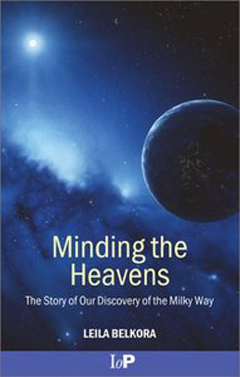
Minding the Heavens
While teaching university astronomy, Leila Belkora enriched the topics being covered by delving into the lives, times, and ideas represented by astronomers whose discoveries have shaped our understanding of the universe. There was little time during her own doctoral research in astrophysics to study the biographies of these scientists, a limitation which motivated Leila to tell the story of the exploration of the cosmos as revealed through the lives of seven prominent astronomers.

Minding the Heavens: The Story of Our Discovery of the Milky Way explores our present understanding of the Milky Way, and its place in a universe of galaxies, through the discoveries made by notable astronomers during the past four centuries. These discoveries have shaped perceptions of our own place in the cosmos; they have defined scientific lines of inquiry; and they have forged a way forward for those who follow.
Our understanding of the universe has evolved over centuries from an initial realization that our solar system is part of a galaxy, to the discovery that our galaxy is one in a universe of galaxies. The successive works of Thomas Wright, William Herschel, Wilhelm Struve, William Huggins, Jacobus Kapteyn, Harlow Shapely and Edwin Hubble have provided answers to many of the questions related to our location in the Milky Way and in the universe.
The Milky Way appears as a band of stars that stretches across the sky and is most visible during the latter half of the year in the northern hemisphere, and earlier in the year for the southern hemisphere. The term 'Milky Way' originated in ancient Greece to describe the misty band of light that forms our stellar system. Galileo turned his telescope to this region of the sky to discover that this mist was made up off a vast crowd of stars.
For the seven astronomers in Minding the Heavens, Thomas Wright was the first to see the stellar system as a three dimensional structure and sought to determine the existence of other stellar systems beyond. William Herschel began the first effort to map the stellar system and to identify its contours. Wilhelm Struve invented the parallax method for measuring interstellar distances. William Huggins opened new areas of research by applying spectroscopy to analyse the chemical composition of light-emitting objects in space, which would become the field of science known as 'astrophysics.' Kapteyn extended this field of research to update Herschel's mapping techniques and to create a model of the stellar system that become known as the 'Kapteyn Universe.' This model was widely adopted until the early 20th century when rival astronomers Harlow Shapely and Edwin Hubble established that the Milky Way stellar system was only one of a vast number of similar galaxies that are scattered across the universe.
Their biographies, and the times in which they lived, bring important insights into the important discoveries made by these seven astronomers. Leila Belkora complements science with history to better understand how our knowledge of the universe has developed during the past four centuries. The journals, private lives, and personal idiosyncrasies of these astronomers add a valuable perspective to the account of how we arrived at our present body of knowledge to form the genesis of continuing explorations in astronomy.




